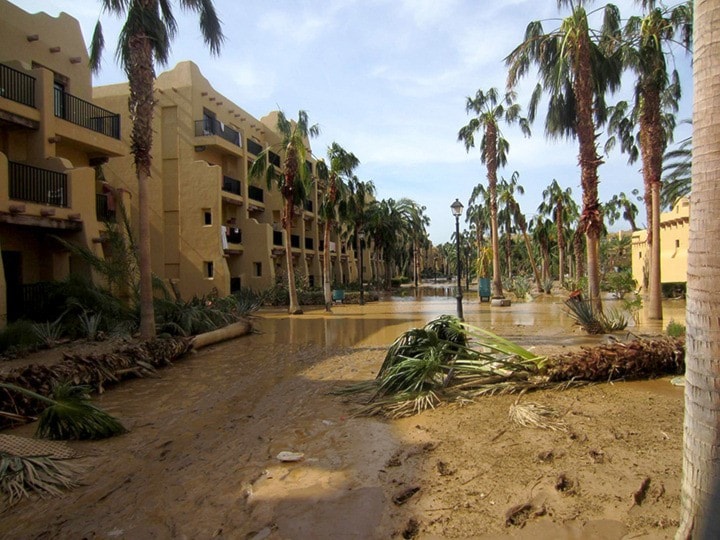The weather was warm, and the mojitos were cold as Kieve Laviolette and Andy Ververgaert relaxed in the pool of the Hotel Riu Santa Fe Cabo San Lucas.
After six years of study, including four in the University of the Fraser Valley business administration program, the Abbotsford couple had just written a grueling three-day exam earlier that week which, if all went well, would earn them their chartered accountant (CA) designation. To celebrate, Laviolette and Ververgaert – together for five years – had flown to Cabo on Saturday, Sept. 13, along with two dozen other CA hopefuls for a comfortable week at an all-inclusive resort.
But four days after they sat beachside, sipping drinks with their friends, Laviolette, 24, and Ververgaert, 27, would be eating stale bread and deep-fried beans.
••••••
The weather reports coming out of Mexico the morning of Sept. 12 were not particularly ominous.
The U.S. National Hurricane Center suggested that swells and riptides from the storm posed the greatest danger to people, and a forecast track had the storm missing the Baja California peninsula and the resort city of Cabo San Lucas at its southernmost tip.

Image: A storm track originally projected the hurricane would miss Baja California.
Saturday morning, Laviolette and Ververgaert flew to Cabo San Lucas as planned.
“The first day was great,” Laviolette recalls, “We hit the pool and had some margaritas and mojitos.”
The next day, the weather took a turn, and the first indication the storm might be something more than an average tropical weather disturbance came from signs posted that afternoon around their hotel, the Santa Fe.
They read: Expect winds. Strong winds. Winds that could reach 260 kilometres an hour. Be in your hotel room by 6 p.m. And it’s probably best if you refrain from drinking.
•••••••
Named Odile, the storm hit landfall as a Category 4 hurricane, with winds of around 200 km/h. It would later be judged the most intense tropical cyclone to hit Baja California since weather satellites began observing storms more than half a century ago.
That night, inside the couple’s fourth-storey room, the noise built to a roar. The glass door rattled loudly in its frame, and in the courtyard below, leaves were ripped from palm trees.
After building for hours, the storm mellowed around 10 p.m. Two hours later, it returned with a vengeance. Odile hadn’t left Cabo San Lucas. In fact, its eye – the centre of the hurricane – had passed directly over the resort. The wall of the eye contains a hurricane’s most ferocious winds.
“It was crazy and way, way worse than before,” says Laviolette.
Electrical power, which had miraculously not yet surrendered to the storm, finally gave up along with the phone system and the Santa Fe descended into darkness. It was impossible to open a door into the hallway because of the dramatic difference in air pressure.
At least five people, four of them tourists, would die from the storm, while more than 100 would be injured.
•••••••
The wind eventually subsided and, after a few hours of sleep, Laviolette and Ververgaert ventured outside. The trees were shredded and the pools were filled with sand. Guests on the first floor waded through water, their bags on their heads.
Elsewhere, a statue in front of a neighbouring hotel had been decapitated, its head dangling by pieces of rope, its body bent backward at the knees.
Many of the other hotels were in far better shape, with power and running water. At one resort, they managed to buy hamburgers from a restaurant. At another, they found guests being served food and alcohol.
It was only on Wednesday that Laviolette was able to get service on her phone to call her family. But some things were improving. Hotel staff had initially disappeared after the storm, but had returned and were serving food – of the soup-kitchen variety – bread and beans, rice and eggs.
“It was awful, awful food, but at least it was something,” Laviolette said.

•••••••
On Thursday at 9 a.m., with their best belongings stuffed in backpacks and a grungy pillowcase, the pair were finally able to make their escape. They were taken by taxi to the airport, where they found themselves in the scariest situation of their trip.
Los Cabos International Airport “was not really an airport anymore,” Laviolette says. The terminal had been closed after taking substantial damage in the storm, and the Canadian couple found themselves at a back of a line on the tarmac “that went for miles and miles.
“The line just wasn’t moving and it was so hot and people were passing out,” Laviolette says. With just two water bottles between them and repressive heat closing in, the couple felt in danger for the first time.
Their saviour came in the form of a woman from the Canadian embassy who said a plane was on its way for stranded passengers from Canada.
The Canadians were plucked from the unending line and – after enduring some heckles – taken to a hangar.
With that relief came a sense they were lucky to be able to fly out of a disaster zone many have to continue living in.
“It was definitely a reality check, just to see how bad the people there were suffering,” Laviolette says. “Just the thought that some people have to live with this, that we can go back to our civilized life, but they have to rebuild.”

•••••••
That night, Laviolette, Ververgaert and 116 other would-be tourists touched down in Calgary, courtesy of a WestJet flight. It was one of four – including two by Sunwing Airlines – that returned stranded tourists to Canada.
Before hitching another plane to Abbotsford the next morning for a reunion with their families, Laviolette and Ververgaert were booked into a hotel.
“It was glorious,” Laviollette says. “We had the best showers we had in our lives.”

